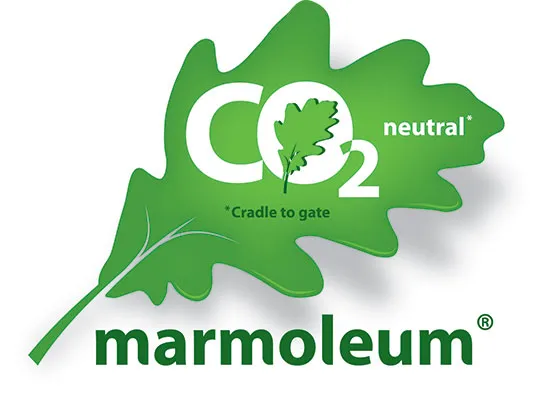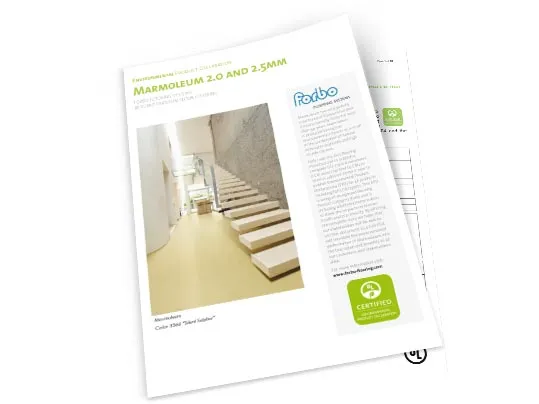CO2 Neutral: A Conscious Choice
Mark Bauer, Environmental Specialist at Forbo Flooring Systems
March 2019

With slow progress being made on the Paris climate agreement, Mark Bauer, Environmental Specialist at Forbo Flooring Systems, explains why we should all be striving to make a conscious choice when it comes to choosing building and interior products – as well as taking a closer look at the difference between carbon offsetting and carbon neutral manufacturing.
Every year, we see more and more extreme weather events occurring around the world, which are being magnified due to the effects of global warming. Indeed, in 2018 alone we witnessed heatwaves across the northern hemisphere, unprecedented wildfires in Sweden, lethal wildfires in the USA, severe flooding in India and typhoons in south-east Asia. Closer to home, the UK experienced both droughts and flash flooding caused by torrential downpours – and while many revelled in the long, hot summer, these weather extremities are, in fact, stark warnings of the growing effects of global warming.
There is little doubt that if we continue on our current path then the world will change – and not for the better. The UN Intergovernmental Panel on Climate Change (IPCC) recently issued a sobering warning that we have just 12 years for global warming to be kept to a maximum of 1.5C above pre-Industrial era temperatures (we’re currently 1C above this level.) While it may not seem like much, an increase of just half a degree above this figure could have catastrophic consequences for ecosystems and communities around the globe; significantly increasing the risk of drought, flooding, rising sea levels, extreme heat and poverty for hundreds of millions of people.

It’s a frightening prospect that needs serious attention and a commitment from both manufacturers and consumers to take more conscious decisions when it comes to choosing the products we make, use and buy. What’s more, manufacturers must do everything possible to enable customers to make responsible choices.
One way of doing this, which has grown increasingly popular in recent years, is through the use of carbon offsetting schemes. Essentially, these programmes look to mitigate carbon emissions produced by an individual or an organisation’s actions, by investing in environmental projects around the world to balance out the overall carbon footprint.
Historically, this was achieved by planting trees to absorb the emissions, but many carbon offsetting companies now offer the opportunity to invest in a much wider range of projects; from renewable energy technologies and methane gas-capture initiatives, to schemes that provide clean water and more efficient cooking stoves to communities in developing countries. This type of project has been designed to offer faster and more lasting carbon savings than tree-planting, as well as delivering significant social benefits to the communities where they operate.

Carbon offsetting, however, is not without its critics – some of whom have been very vocal indeed. Writing in The Guardian newspaper more than a decade ago, journalist George Monbiot published a blistering damnation of the concept, which was still relatively new at the time. He likened it to the 15th century practice of ‘paying for your sins’, whereby murderers and other criminals could receive absolution by making financial donations to the church.
In the years that followed, similar criticism has been levelled at carbon offsetting time and time again: that the concept allows people to continue their damaging practices, without addressing the fundamental problems that need to be solved in order to achieve permanent change.
The harshest critics argue that carbon offsetting does little more than appease guilty consciences, while burning through resources and spouting out emissions with the same insatiable greed and unsustainable pace as before.
Supporters of carbon offsetting, however, refute such claims, insisting that most individuals and organisations use this option as part of an overall environmental strategy, which includes reducing emissions at the source where possible. Whatever the case, it’s clear that minimising environmental impacts at all stages of the production process is the most effective way to reduce the carbon footprint of the goods and materials we all use – and this is where carbon neutral manufacturing has its strength.
Carbon neutrality – or having a net zero carbon footprint – means that the carbon produced during the manufacturing process is sequestered by a similar amount, thus resulting in an overall neutral balance. A good example of this in the flooring industry is the production of some linoleum floor coverings, which are an extremely sustainable choice.
Linoleum is made from natural renewable materials that can be harvested from annual crops, such as flax and jute, or obtained as recycled wood from controlled forestry plantations. Created with ingredients including linseed oil, pine rosin, wood flour, limestone and jute – it’s possible for linoleum to be manufactured as a truly carbon neutral product in the cradle to gate stages of the product's life cycle without the need for carbon offsetting, because the natural materials absorb such high levels of CO2, while the production process itself requires comparatively little energy.


This is great news for specifiers who wish to reduce the carbon footprint of their projects but it’s important to be sure that their chosen supplier can prove the validity of any environmental claims. One way to do this is to look for manufacturers that are backed by an independent Environmental Product Declaration (EPD).
This independently verified and registered document communicates transparent and comparable information about the life-cycle environmental impact of a product. What’s more, some manufacturers – including Forbo – go beyond the requirements of the PCR (Product Category Rules) that are followed in producing an EPD by also declaring the impacts on human health and eco toxicity.
Choosing products that have been manufactured in this manner is the easiest way to reduce the carbon footprint of a project. For example, using a suitable linoleum product with full EPD backing on a 10,000m2 project, could equate to a 66,200kg/CO2 saving, when compared to a PVC vinyl floor.
There’s no denying that mitigating climate change is a huge challenge, but the consequences of not tackling this problem are grave indeed. However, making conscious decisions about the products and materials we use at home and at work will go a long way towards achieving this goal and working with a responsible manufacturer is one of the key ways to do this.